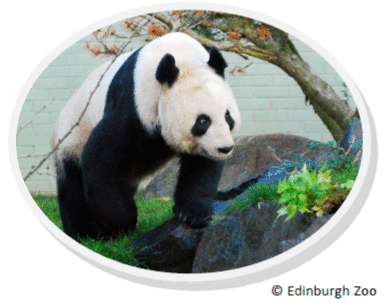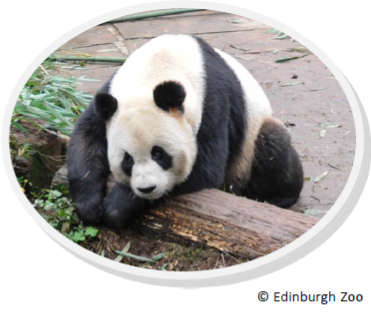The giant panda fact file
The Giant Panda
(Ailuropoda melanoleuca)
Size: The giant panda is a medium sized bear.
Length: 120-150cm
Tail: 12-15cm
Weight: 85-125kg
Paws: They have an overgrown bone on their front paws which helps them to grip their bamboo.
Senses: The giant panda has an excellent sense of smell. The senses are very important to the male and female when communicating and finding each other for mating.
Teeth: The giant panda has evolved broader back molars compared to other bears. These molars are better for chewing bamboo.
Food: The giant panda mainly eats bamboo, About 99% of their diet is bamboo but they will also eat fruits, small mammals and birds. They can eat about 17kg stems per day (that's about 600 stems).
Habitat: The giant panda lives high in the mountains of western China, mainly in Sichuan but also in Gansu and Shaanxi. Temperatures can range from 4-15oC and they can live in altitudes of 2,500m. In summer they will move to higher places for cooler temperatures and in very cold winters they will come down from the mountains for warmth.
There are many other animals in the forests such as - red pandas, takins, leopards, golden cats and Sichuan golden monkeys.
Babies: The giant panda gives birth to a tiny baby about 15cm long. The baby has usually need inside mum for 5-8 months although the actual growing time is probably only 4-6 weeks. This is due to delayed implantation which means that the baby is inside mum but isn't growing. Mum can give birth to 1 or 2 young but when 2 cubs are born, the mother will usually only rear the stronger cub.
Lifestyle: Giant pandas are solitary which means they live on their own. They will mark their territory to warn away other male pandas. They shelter in trees and caves. They are good climbers and can swim. They tend to be active at night time or early morning and early evening but to save energy they do sleep a lot of the day. On average around 8-9 hours sleeping and around 14 hours looking for and eating food which is mainly bamboo.
Growing up: A cub will spend about 18 months to 2 years with their mother. During this time, the cub will learn how to find bamboo and water, how to shelter from danger and how to fight.
It's not all black and white: Brown and white pandas are found in Shaanxi. Research has shown that the brown and white colouring is probably due to a genetic mutation, which means a change in the genes that has caused a difference from the norm. It is important to note that there is quite a lot of brown hair on a black and white panda.

From 'Panda - Back from the Brink', introduction by Dr. Iain Valentine, formerly Director of Giant Panda Project and Strategic Innovations with the Royal Zoological Society of Scotland:
"China is a nation that will undoubtedly have a major role in shaping the world's future, and so its actions will impact on us all in many ways in the years to come. Through pandas we can learn much more about this diverse country - its people, its culture, its politics, its rich environment and wonderful biodiversity. We can learn more about China's environmental efforts, and we can share with China our own knowledge and experiences to further our own conservation efforts here in the UK...
The Chinese government continues to allocate tremendous resources to the conservation of this species and the habitats that giant pandas occupy...
I struggle to think of any other species that can motivate the human race in the way pandas can: to provoke thought and to inspire us all to will the species on to become a resounding conservation success story."
